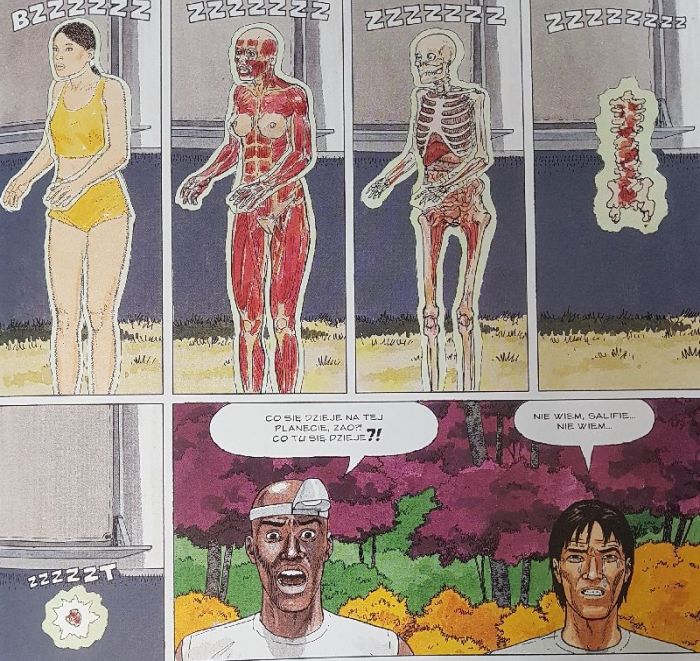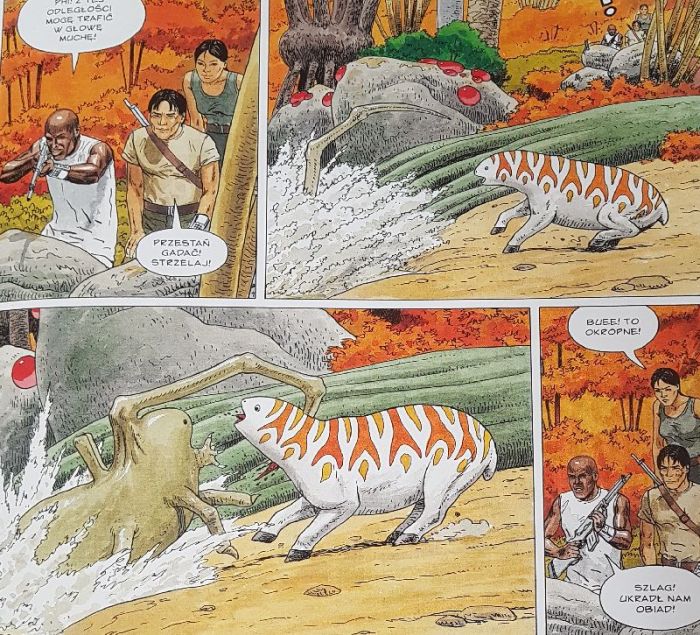The previous volume of the science-fiction series from the Brazilian screenwriter / cartoonist Léo (Luiza Eduardo de Oliveira) – Betelgeuse – aroused ambivalent feelings in me. I was bought by the exploration of the eponymous planet, which the author inhabited with dozens of fantastic species of flora and fauna. The writer also deserves praise for strongly emphasizing the themes of ecology and the ethics of planet colonization (similar to the “Prime Directive” from Star Trek) and starring women. However, this is where the screeching begins, because all the female representatives are written in a “cheeky” way. The “male gaze” poured out of the dialogues (in which someone constantly complimented the beauty of the protagonist), and naked breasts appeared every few pages. Follow- ups tend to deliver more of the same, and that is also the case in Antares .
Kim Keller in action
The Betelgeuse mission proved to be a failure. The planet was inhabited by the intelligent sloths of Jouna’s sloths, so humanity could not settle there. The earth, however, is in a deplorable condition – shrouded in smog, devoid of numerous animal species (and yes, we are talking about the future, not the present – although it sounds similar). Therefore, the project “Antares”, consisting in the exploration of another celestial body suitable for human habitation, was planned. Are you sure? Kim Keller once again embarks on a mission to explore an alien planet. This time the environment is even less friendly, full of unexplained phenomena (such as the literal disappearance of organisms), and the threat also has an internal dimension. The principals, Forward Enterprises corporation, appears to be a place full of religious fanatics who will go so far as to

Kim Keller, my love
Kim Keller is an amazing person. Kim Keller is extremely intelligent. Everyone loves Kim Keller. Kim Keller is beautiful and has nice breasts. Everyone wants to sleep with Kim Keller. Kim Keller can survive any situation. Kim Keller, Kim Keller, Kim Keller! It sounds artificial? Unfortunately, this is how the plot is built and, worse, the dialogues.
The main character is sent to Antares because of her status and popularity. On the spot, she takes part in almost every mission, and her reason is always the best. In this way, she became an even bigger “marysujka”. In the previous part, there was a situation where a representative of an intelligent race of aliens decided to sleep with her, and as a result the first child-hybrid of two species was created. Unfortunately, despite all these phenomena, the protagonist does not have much charisma. This is a different character using the substance from the mantrissa, Aleks Komarov, he is definitely more go-getting and active. The same cannot be said for most of the other supporting characters that Léo treats neglectfully. New characters seem to experience some drama, but the script may completely forget about them at some point. Romantic threads are run in a very naive way. The heroes show a lot of urgency, and all the dialogues about who they like and how much they would like to sleep together resemble harlequin novels. At the end of the story, there are also times when Kim and Co. are pulled out of the fray by a brand new character instead of someone from the current crew, which would make for a more coherent scenario.

Industry
Among the heroes of the second plan, the brothers Elijah and Jedediah Thornton from Forward Enterprises stand out, for whom space exploration is combined with deep spirituality. The trip to Antares is to be an opportunity for them to meet the Creator. To this end, the ship’s crew consists largely of members of the fundamentalist sect led by the Thorntons. Interesting concepts appear here – such as, for example, women shaving their heads and wearing inflated costumes so as not to “tempt” men (this is even a step further than the Puritan costumes from the Handbook Tale)). Léo, however, misses this theme by focusing on a very little refined critique of religiosity. You can see that the screenwriter wanted to say something important about following the faith blindly and about the corruption of the religious hierarchy, but all this is sewn with thick threads. Jedediah, who is at the head of the cult, is a caricatured character, which emphasizes both his idiotic behavior and screaming in every dialogue, and the way in which he was drawn (a face with an eternal grimace of disgust). I had the impression that this whole thread of the sect arose only so that Léo could vent his frustrations.
That’s a cliche, but I also can’t ignore the fact that characters tend to address each other by name (“Oh, of course, Jedediahu”). Yes, it is worth appreciating the use of a forgotten vocative, but in a situation in which people know each other well (they are brothers!), It is very artificial.

Herbarium and bestiary
Léo loves drawing plants and animals. Every few pages a new species appears to show the uniqueness of the alien planet’s nature. Nevertheless, I have a growing impression that the artist, apart from a few exceptions, has not thought about how the ecosystem he created is supposed to work. Some of the creatures created by Léo do not make any sense – such as an animal that looks like two antelopes standing on top of each other (this organism has a torso first, then legs, then a torso and other legs). It will probably not be felt by many recipients, but I cannot miss it – especially in a situation where xenobiology is such a large part of the whole.
The flora and fauna are at least pleasant to look at. The same cannot be said of the people Léo still draws ugly. The facial expressions of the characters can be terrifying. The smiling characters resemble the combination of the meme “Hide the Pain Harold” with the tense smile of the people of Zonzo created by Joan Cornella. In addition, they are presented in very static poses, all closed in rectangles and squares typical for francophones.

Play it again, Léo
The above review is very negative. Worshiping all the characters for Kim Keller is absurd, and so is popping out with a shank every few pages. Ecological themes and criticism of religion are presented in an infantile way. The six-episode series was originally created in the years 2007–2015, and reading it, I had the impression that I was dealing with several dozen years older Ramota. And yet I do not regret the time spent reading. Despite all these drawbacks, Léo’s comic book can intrigue and catch the reader’s attention. I will certainly reach for the next part of the series, for example as a kind of guilty pleasure .

